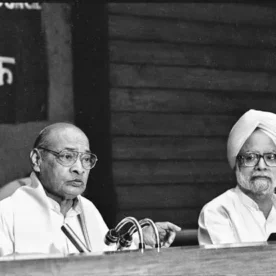Here we present to you Notes on Economic Reforms in India since 1991. The economic reforms process of 1991 had Liberralisation, Privatisation and Globalisation as three pillars. Notes presented here are concise, however, they cover every aspect of the chapter.
Main Points
ToggleIntroduction
Although, India’s economy grew only 4% per annum during 1950-90, it was able to develop a diversified industrial sector, increase in saving rates and achieve food security. However, it was marred by poor performance of public sector, Inflation, burden of debts, deficit in balance of payment, large scale corruption and mismanagement of resources. Ultimately this led to Foreign Exchange Crisis (adequate for payment of two weeks import only) in 1990-91. India went to IMF and World Bank for loans which granted loans of USD 7 billion on condition that India would liberlise its economy. At last, in July 1991, the then Finance Minister Dr. Manmohan Singh (PM between 2004-14) announced New Economic Policy.
Under New Economy Policy, India took stabilization measures (correcting balance of payment crisis and controlling inflation) and Structural Measures (increasing efficiency and removing rigidities the economy through liberalization and privatization)
Three Pillars of New Economy Policy were (i) Liberalization (ii) Privatization and (ii) Globalization.
LIBERLIZATION
Under Liberalisation, reforms were initiated in various sectors like industrial sector, Financial Sector, Foreign Sector.
Industrial Sector Reforms:
Industrial License: Except 6 industries (1. Distillation and brewing of alcoholic drinks 2. Cigars and Cigarettes of tobacco and manufactured tobacco substitutes 3. Electronics 4. Aerospace and Defence Equipment 5. Industrial Explosives 6. Specified Hazardous Chemicals), compulsory industrial license has been abolished. Moreover, there is no need of license to set up new units and expansion & diversification of existing production.
Most of the industries were also opened for private sector. Now only Atomic Energy and some railway operations are reserved exclusively for Public Sector.
Many items earlier reserved for Small Scale Industries were de-reserved and MRTP Act (Monopoly and Restrictive Trade Practices Act) was replaced by Competition Act-2002 to enhance competition in the market.
Financial Sector Reforms:
RBI role was changed from a regulator to a facilitator. Now, financial institutions could make many decisions on their own. Reforms paved way for private banks and foreign banks. Limit of foreign investment in banks was increased to 74%. Banks could set up new branches without approval of RBI.
Tax Reforms:
Direct Tax rates were gradually reduced while many indirect taxes were merged in GST.
Foreign Exchange Reforms:
To increase exports and attract foreign investments, India devalued its currency. Later on, it adopted market determination of foreign exchange rate with RBI’s intervention to check the FER within limits (Managed Floating System of FER determination).
Trade and Investment Policy Reforms:
To increase exports and attract foreign investments, India devalued its currency. Later on, it adopted market determination of foreign exchange rate with RBI’s intervention to check the FER within limits (Managed Floating System of FER determination).
Privatization
Privatization means transferring ownership, management and control of public sector enterprises to the private sector. Privatisation can be done in two ways: outright sale of Public Sector Undertakings (PSUs) and sale of shares of PSU to private sector (Disinvestment). Moreover, to increase effectiveness of PSUs, they were given some autonomy and categorized in Maharatna, Navratna and Miniratna based on profit and some other criteria.
Globalization
It means integration of economies of the world with each other. The integration can happen mainly through international trade and foreign investment.
To further integrate Indian Economy with rest of the world, India has removed many restrictions on foreign trade and investment. Moreover, Rupee has been made fully convertible in current account transaction and partial convertible for capital account transactions to increase volume of trade and investment.
Effect of Globalization:
Globalisation provide better technology, more competition and opportunities to earn more. However, Globalisation has been criticized for increasing consumerism, benefiting developed nations more while compromising welfare of poor nations.
Outsourcing:
It means hiring services from external sources especially from other countries. Growth in information technology has increased the level of outsourcing services.
India has become favourable destination for outsourcing due to availability of cheap & skilled workforce.
World Trade Organization:
WTO was established in 1995 as a successor to GATT (General Agreement on Trade and Tariff-1948). It has more than 160 countries. Its function is to liberalize international trade with rule based trading. However, it is alleged that WTO works in favour of developed nations as markets of developed nations are not as accessible to developing nations as their markets are for developed nations.
Demonetization
Central Government demonetized currency notes of Rs. 500 and Rs. 1000 on Nov. 8, 2016. It was targeted to weed out black money, terror financing, promoting cashless economy and channelizing savings into formal finance system, increasing tax compliance.
Demonetization helped in digitalizing the economy transactions, increasing tax compliance. However, it is debatable whether it reduced black money as most of the money was deposited with banking system. Moreover, people had to suffer greatly as they had to queue in line for many hours. Small business which dealt in cash also suffered.
Goods and Services Tax
Implementation of GST from July 2017 was a step towards ‘One Nation and One Tax’. 17 indirect taxes and 23 cess were merged in GST. It is charged on each stage of value added. The final burden is borne by the consumer. Producers/sellers of the product can get input credit at each stage of value chain to avoid tax on tax.
There are three types of GST – 1. Central GST (within the state supply) 2. State GST (within the state supply) 3. Integrated GST (inter-state supply)-equivalent to sum of CGST and SGST and collected by the Centre.
An appraisal of LPG policies
Arguments in Favour:
India has witnessed tremendous GDP growth especially post 2000. Its foreign reserves have touched USD 600 billion marks while it has inflow of billions of dollars as FDI. India has become a destination for outsourcing services and also considerably increased its exports. India has been able reduce inflation from 17% in 1991 to around 6% in 2015-16. Private sector has expanded at exponential rate and people now have variety of goods to consume.
Criticism of Economic Reforms:
Economics reforms did not generate sufficient employment opportunities leading to growing unemployment.
Economic Reforms neglected agriculture and it did not grow as expected. It suffered due to reduction of public investment & subsidies and cheap agro-imports.
Moreover, Industrial growth also remained low due to lack of infrastructure facilities, non-tariff barriers by developed countries and cheaper imports affecting domestic producers.
It spread the evil of consumerism which has resulted in production of more luxurious goods neglecting the production of goods demanded by the poorer section of the society.
Moreover, reforms have mainly helped growth in service sector especially of telecommunication, IT services, Finance etc. However, it has not been able to absorb extra workforce of primary sector.
Frequently Asked Question on Economic Reforms in India
Q.1 What were Prime Minister and Finance Minister of India when New Economic Policy-1991 was adopted?
Ans: Prime Minister was P V Narsima Rao and Finance Minister was Dr. Manmohan Singh.
Q.2 Which were the main reason for economic reforms in 1991?
Ans: poor performance of public sector, Inflation, burden of debts, deficit in balance of payment, large scale corruption and mismanagement of resources.
Q.3 What was immediate reason of economic reforms-1991.
Ans: Balance of Payment Crisis/Foreign Exchange Crisis was the immediate reason for economic reforms as India had foreign exchange for import of only two weeks.
Q.4 What was the amount of loan provided by the world bank and International Monetary Fund to India to avoid foreign exchange crisis in 1991?
Ans: USD 7 Billion.
Q.5 What is the full name of World Bank?
Ans: International Bank for Reconstruction and Development (IBRD)
Q.6 When World Bank and International Monetary Fund were established?
Ans: They both were established in 1944 at Bretton Woods, USA.
Q.7 What is an industrial license in India?
Ans: An Industrial License is written permission by the government to an industrial unit to produce specific goods and services.
Q.8 What is MRTP Act?
Ans: Monopolistic and Restrictive Trade Practice (MRTP) Act was implemented in 1969 to remove the possibility of concentration of economic power in the hands of few people.
Q.9 What is aim and objectives of Competition Act- 2002?
Ans: The act focusses on to promote and sustain competition in Indian markets while protecting consumers’ interest the interests of consumers. It also ensures freedom of trade carried on various participants in the market.
Q.10 Which act replaced MRTP Act-1969?
Ans: Competition Act -2002.
Q.11 What is the full form of RBI?
Ans: Reserve Bank of India.
Q.12 When was RBI established?
Ans: RBI was established in April 1935 under RBI Act-1934.
Q.13 Which foreign exchange system is called Dirty Float?
Ans: Managed Floating System. In this system, foreign exchange rate in determined by the market forces of demand and supply. However, the government/central bank of a country intervenes in the market to keep the exchange rate within limits. It does so by selling and buying foreign currency in the market.
Q.14 When was World Trade Organisation established?
Ans: In 1995.
Q.15 What is the full form of GATT?
Ans: General Agreement on Tariffs and Trade.
Links for our other valuable recent posts

CBSE Class 12 History Answer Key 2025 Paper Code 61/6/1 Free with explanation

CBSE Class 12 Biology Answer Key Paper Code 57/7/1 – with great accuracy

CBSE 2025 Economics Answer Keys Paper Code 58/5/1 – Free and accurate

CBSE class 12 Economics Answer Keys 2025 with explanation – Free and authentic




